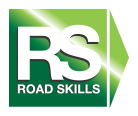Do your drivers know how and where to position warning cones or triangles if they’re involved in an incident while on the road?
Here’s what the Highway Code has to say on breakdowns (Rule 274):
Put a warning triangle on the road at least 45 metres (147 feet) behind your broken-down vehicle on the same side of the road, or use other permitted warning devices if you have them. Always take great care when placing or retrieving them, but never use them on motorways.
So how far exactly is that?
One quick way to get it right is to train your drivers to use their vehicle length as a guide. Here are some examples…
• A Ford Focus (small car example) is approximately 4.5 metres long, so 45 metres is about 10 times the vehicle’s length
• A Ford Transit Custom van (van example) is approximately 5 metres long, so 45 metres is about 8 the vehicle’s length
• A rigid vehicle is approximately 12 metres long, so 45 metres is close to four times the vehicle’s length
• An articulated vehicle is approximately 15.5 metres long, so 45 metres is just under three times the vehicle’s length
• A road train (a combination of a lorry and a trailer) is approximately 18.75 metres long, so 45 metres is almost 2½ times the vehicle’s length
The Highway Code also has this to say on breakdowns…
If your vehicle breaks down, think first of all other road users and
• Get your vehicle off the road if possible
• Warn other traffic by using your hazard warning lights if your vehicle is causing an obstruction
• Help other road users see you by wearing light-coloured or fluorescent clothing in daylight and reflective clothing at night or in poor visibility
• If possible, keep your sidelights on if it is dark or visibility is poor
• Do not stand (or let anybody else stand) between your vehicle and oncoming traffic
• At night or in poor visibility do not stand where you will prevent other road users seeing your lights.
Reminding your drivers about sections of the Highway Code helps them feel valued, so you’re not only fulfilling your duty of care to them and your work-related road safety obligations, you’re also building key relationships.
And it’s worth remembering that you’ll need to demonstrate your drivers are fully conversant with the Highway Code D2 when you’re preparing for your next FORS Bronze audit. Make sure that you have issued the most up to date copy of the The Highway Code to your drivers – you can use this link to obtain copies through FORS using the discount which is available to you as FORS Members.


 Paul Nicholas Carter is known as Nick and has had over 30 years in the haulage business as a Director of his own multi-faceted transport company and, as such, had responsibility for finance, compliance and safety. He was one of the very first hauliers to attain FORS in Yorkshire (that is when he met David) and to achieve ISO 9001& 14001. Nick soon realised David’s system for introducing and maintaining FORS within a business was beneficial on so many levels and easy to use for staff training. It also became apparent that FORS gave him a competitive edge in being able to tender for contracts involving deliveries and specialist haulage projects within London.
Paul Nicholas Carter is known as Nick and has had over 30 years in the haulage business as a Director of his own multi-faceted transport company and, as such, had responsibility for finance, compliance and safety. He was one of the very first hauliers to attain FORS in Yorkshire (that is when he met David) and to achieve ISO 9001& 14001. Nick soon realised David’s system for introducing and maintaining FORS within a business was beneficial on so many levels and easy to use for staff training. It also became apparent that FORS gave him a competitive edge in being able to tender for contracts involving deliveries and specialist haulage projects within London. David launched Road Skills in 1991 after recognising that too many fleet operators were not getting the training and support they needed to operate safely and profitably.
David launched Road Skills in 1991 after recognising that too many fleet operators were not getting the training and support they needed to operate safely and profitably. Rosemary has been with Road Skills since 2009 and brings a wealth of experience to keeping the company’s finances running smoothly and supporting the rest of the team.
Rosemary has been with Road Skills since 2009 and brings a wealth of experience to keeping the company’s finances running smoothly and supporting the rest of the team. Victoria has been with Road Skills since 2008, bringing many years’ experience in administration to the team.
Victoria has been with Road Skills since 2008, bringing many years’ experience in administration to the team. Ian is a former roads policing chief inspector and has a Masters degree in Occupational Safety & Health who has been with Road Skills since [YEAR].
Ian is a former roads policing chief inspector and has a Masters degree in Occupational Safety & Health who has been with Road Skills since [YEAR]. Callum leads FleetCheck’s direct sales team and is a key Road Skills partner, demonstrating the fleet management system to Road Skills clients and prospects.
Callum leads FleetCheck’s direct sales team and is a key Road Skills partner, demonstrating the fleet management system to Road Skills clients and prospects. Susie joined Road Skills as Marketing Manager in 2016 after working with the company on an advisory basis for several years.
Susie joined Road Skills as Marketing Manager in 2016 after working with the company on an advisory basis for several years.
 Bill is a retired police officer and driving instructor who joined the Road Skills team in 2011 and specialises in carrying out risk assessments and pre-FORS audits following the FORS PASS process.
Bill is a retired police officer and driving instructor who joined the Road Skills team in 2011 and specialises in carrying out risk assessments and pre-FORS audits following the FORS PASS process.